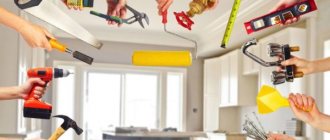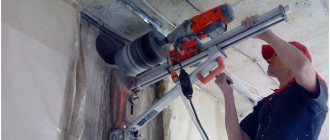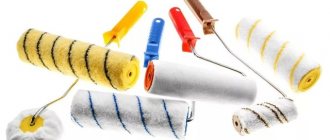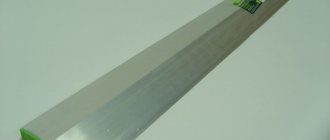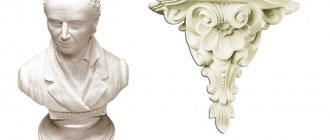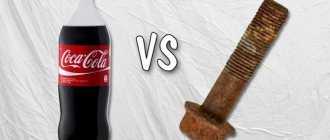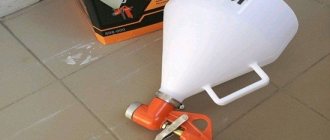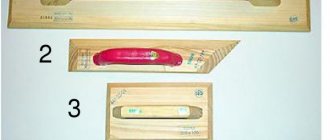Not a single repair can be completed without using a spatula. This seemingly simple tool is used for removing wallpaper, removing an old layer of paint or peeling plaster, and laying tiles. It is very convenient to use it to determine unevenness on the surface of walls or floors; you just need to press the blade perpendicular to the base and make sure there are no gaps. It is used to trim excess wallpaper by applying it to the edge of the canvas and cutting off the excess wallpaper with a utility knife.
And its direct purpose is the application and leveling of putty mixtures. Spatulas differ in the shape and size of the blade, the presence or absence of a handle, and the material from which they are made. To perform each individual procedure, a certain type of spatula is used. A separate group of spatulas is designed for wall puttying and painting and plastering work.
Dimensions
By width, ordinary metal spatulas are divided into narrow, medium, wide:
- A narrow tool is considered to be a tool with a working plate 5 to 10 cm wide. With its help, it is convenient to scoop up plaster or putty mixture from a bucket and throw it on the wall. The small width also makes it possible to plaster in hard-to-reach places. It is difficult to level the solution over the surface being treated with such a tool.
- Medium products include products with a blade 15-25 cm wide. Individual large dents are puttied with this spatula. The tool is well suited for leveling small areas and grouting gypsum board joints.
- Wide (facade) spatulas are equipped with a plate larger than 25 cm. Available sizes: 30, 35, 40, 45, 60, 80 cm. They are used mainly for rough finishing and leveling of mortar over large areas. Along with a float, this spatula is used for glossing plastered surfaces.
Types of plaster
Depending on the purpose and size of the fraction, American plaster is classified as follows:
- Facade. Includes fillers of the largest fraction, which make the material very durable and resistant to mechanical and physical factors. Such building mixtures are not afraid of precipitation, UV radiation, or temperature changes. Facade compositions have anti-vandal properties, because they are not easy to damage.
- For residential premises. Contains the smallest particles of filler, so the finished coating is smooth, pleasant to the touch, and beautiful.
- For office premises. The fillers in such mixtures differ in their average fraction size, so office “Americans” can be considered universal. They are usually used to decorate rooms with high traffic and an increased level of load on the walls. Most often, “office” plasters are painted in basic shades - gray, brown, beige.
In addition, the collections of “American” plasters from some manufacturers include the Industru line - it is excellent for finishing warehouses, workshops, and other industrial premises.
The special qualities of the filler in such products make it possible to reliably hide the imperfections of the base, as well as reduce the need for careful preparation of the walls before applying the mixture. Also among the assortment of many manufacturing companies you can see the Comfort line, where plasters are produced already tinted in light, fresh colors.
The composition of the plaster also differs greatly from each other. The following substances may be present as a basis in “American”:
- Mineral components (lime, cement). The mixtures are inexpensive, vapor-permeable, and do not disturb the indoor microclimate.
- Polymers. Synthetic resins give materials increased resistance to ultraviolet radiation, moisture, and temperature changes. Such plasters create a more pronounced decorative effect.
- Silicates. They contain liquid glass, which provides the highest strength and resistance to damage by fungus and microorganisms.
- Silicone. The addition of silicone resin along with sand and marble increases the elasticity of the plaster, eliminates the risk of cracking and guarantees excellent tolerance to any load.
As additives, mother-of-pearl or metallized chips are introduced into many plasters - they give the coating an original look and also increase the ability to repel water and dirt.
Serrated
When laying tiles and stone tiles, a notched trowel, also known as a comb, is often used to apply the adhesive. A distinctive feature of the tool is the teeth located on the edge of its blade. It turns out that the glue is laid on the wall in grooves.
Advantages of the method:
- High performance. With this method of application, the solution is evenly distributed under the tile, filling the voids. As a result, the master does not have to waste time squeezing out and removing excess.
- Quality of tiles. The tile lays flatter than when applying glue with a regular sheet due to its more even distribution under its surface. The necessary strength of the connection is also ensured.
- Saving. Helps avoid overuse of glue, reducing financial costs.
Other areas of application of a notched trowel: creating textured decorative plaster, laying parquet, applying glue to insulation.
Textured decorative waves from the teeth of the tool.
Expert opinion
Sergei Shablovsky
Plasterer
Tip: The thickness of the applied adhesive solution can be changed by increasing or decreasing the angle of inclination of the spatula to the surface to be treated.
Deciding on the type of tool
In modern construction, 4 types of spatulas are used:
- for painting work;
- rubber tools;
- notched spatulas;
- façade devices.
Each of the devices has its own positive aspects, which is important when carrying out finishing work.
Rubber
Another interesting variety. In its most primitive form, it is a piece of rubber with a cut edge. Flexible synthetic material does not scratch the surface, it is also quite wear-resistant and durable.
Set of three sizes.
Use a rubber spatula to rub the seams of ceramic tiles, as well as the places where silicone sealant is applied.
The tool is well suited for working with convex and concave shapes: rounded corners, columns, arches.
Professional finishers often have a whole set of small rubber spatulas in their toolbox for this purpose.
Painting variety
The product of this group has the following characteristics due to which they are selected:
- purpose – applying putty to the surface;
- blade elasticity;
- thinness of the blades;
- economic benefit of price.
If you choose a spatula for applying heavy mixtures and performing operations with a large load, it is worth purchasing devices of other varieties.
Plastic
The main area of application of plastic spatulas is wallpapering. Due to their shape and elasticity, they effectively squeeze out the air from under them and press the canvas tightly against the wall without damaging it. The second name of this tool is a pressure spatula.
The following forms of devices are available for sale:
- Classic . It differs from a wide metal spatula only in material. Convenient to work with large areas and heavy wallpaper.
- Trapezoid . A compact instrument similar in appearance to a rectangular trapezoid. Quite versatile, because it allows you to work not only with a straight, easily accessible surface, but also with corners.
- Shark fin . Has special slots on the working surface. This tool makes it easy to apply adhesive to wallpaper and walls. Equally effective when smoothing the central part of the wall and corners.
- Boat . Semicircular plastic spatula with a convenient holder. Designed to work with hard-to-reach areas.
For applying decorative paint.
Expert opinion
Alexander Guryanov
Plasterer and decorator
If necessary, a plastic sheet can be adapted for applying texture to a plaster coating by cutting teeth on it. This is how you can make ornaments: wave, circle, tree, Christmas tree, stripes.
Selection rules
Construction stores are literally littered with tools from different manufacturers, cheap and expensive. There are several tips that will help distinguish low-quality from high-quality:
- Pen. A good model fits comfortably in the hand and does not bend. There are no plastic deposits or burrs on the surface. You shouldn’t settle for the option with a black molded handle made of cheap plastic. This is a low quality indicator;
- The length should correspond to the task and not make work difficult. Too long will sag, short will hurt your hand;
- Shape of the canvas. The best option for classic plaster and putty is a trapezoid;
- Quality of the canvas. Flexibility is the main indicator of a good tool. If the blade flexes too much when pressing, the solution will fall off. A working part that is too hard may burst under pressure. The best option is a blade that is slightly springy;
- Canvas material. The most practical option is stainless steel. It is not destroyed by water and is easily cleaned from the solution. There are cheap models made from simple iron. They are characterized by low quality, short service life;
- A high-quality model has a dull blade.
Manufacturers can be divided according to the level of trust and popularity among ordinary users:
- The most rated, expensive and high-quality tools are produced by Sheetrock, Stayer, Anza
- In the middle segment in terms of price and quality, we can highlight Kraftool, Zubr
- In the budget segment, Fit and Brigadier stand out
Repair and finishing work is not complete without a spatula. It is mainly used in decoration. Using a spatula, seal the smallest cracks in the surface of walls and ceilings, applying putty or glue to them. This device also helps in cleaning walls from old wallpaper and paints.
The spatula is distinguished by its versatility and the ability to be used as a tool for finishing work. Many people faced with the problem of repair and finishing are wondering which spatula is better to choose?
Brief contents of the article:
"Japanese spatula"
A tool specifically designed for applying decorative plaster, such as Venetian. Made from high quality stainless steel. They are not equipped with a handle, but may have a plastic holder on one side of the work plate. This unique design allows for better control over the application of decorative plaster.
A set of “Japanese” from Pavan (Italy).
The plate itself is distinguished by high quality workmanship, a perfectly smooth surface and the absence of the slightest burrs at the edges. As a result, the surface of the decorative plaster is smooth, without tool marks.
Technology for applying Venetian plaster with a Japanese spatula:
- A small amount of decorative mortar is poured onto the edge of the tool and applied to the wall with gentle movements in different directions. The master holds directly onto the metal plate. For best results, the blade should be at an acute angle to the surface being processed.
- A second layer of a different shade is applied to the wall in a similar way and shaded.
- The plaster should now be completely dry.
- After this, wax is applied and the surface is polished with a sponge.
An interesting video on the topic: how to use a Japanese spatula when applying “Venetian”.
Criteria for choosing a quality tool
The best tool for finishing work, according to many finishing craftsmen, is considered to be a metal spatula made of stainless materials. The tool has several advantages:
- service for a long time;
- convenience during work;
- ease of cleaning from primer, glue and other substances;
- the tool is almost impossible to bend and break.
To make the spatula comfortable, you should pay attention to how it lies in your hand and what type of handle it has. If the handle is short and thick, then this will be very important when carrying out work. Tools with a long handle help to increase elasticity when pressing on the surface being treated.
If the handle is made of wood, then when purchasing, you should pay attention to the presence of nicks or burrs. A plastic or rubber spatula is preferable due to the absence of any roughness on the surface of the handle. A perfectly smooth tool helps to finish the surface of walls quickly and efficiently.
When choosing a device, you should pay attention to the fastening of the working surface. It is important to pay attention to the elasticity of this part.
To determine this, you should slightly bend the spatula; to do this, grab the handle with one hand and the work surface with the other and press. If you can see a bend, then you should abandon this tool.
Read also: How to check the ignition module with a tester
To make the process enjoyable, you need to pay attention to the quality of the device. If you can see any grease on the blade of the working part, then most likely the spatula is of poor quality.
In its production, ordinary iron is used, which is then coated with a special coating, due to which the working surface acquires a shine. After some time, the spraying substance is abraded, and the tool becomes deformed, that is, it goes out of use.
Multifunctional
This multi-purpose spatula is useful in many painting and plastering projects. Its steel blade is thicker than a regular one, and its rigidity is increased. Its second name is a spatula-scraper.
Spatula scraper (Hardy).
It has a lot of purposes:
- Removing wallpaper and old paint from the wall;
- Cleaning the paint roller lint (with a semicircular notch);
- Joining cracks and cutting drywall with an acute angle;
- Pulling out small nails;
- Cleaning tile joints;
- Opening lids on paint cans, etc.
History of appearance and composition
The idea of creating a mixture came from Latin America, hence the name - American plaster. The material appeared on the domestic market relatively recently - in the early 90s.
The stucco is named American after its origin. The manufacturing technology was invented in Latin America.
The mixture contains binders that provide good adhesion to the wall:
- lime,
- silicate resin,
- gypsum,
- cement,
- fractions of different sizes, depending on the need for finishing,
- additives to impart antiseptic and vapor-permeable properties.
Plaster has been used in building finishing for many centuries, but has acquired its wear-resistant qualities thanks to modern ingredients and manufacturing technology.
The design on the mixture is created manually and always has a unique pattern.
The mixture is sold in dry form, it is brought to a liquid state by adding water. The proportions are described in the instructions for using a specific type of plaster.
"Under the tree"
A semicircular rubber spatula does not smooth out the plaster, but, on the contrary, gives it a specific texture reminiscent of wood. This tool is as easy to use as a regular one.
More information about decorative plaster “like wood” and about making a spatula with your own hands is described in this article.
Using smooth movements, they move it over the freshly laid mortar, rolling it as it moves. This is how the structure of the wood appears on the wall, after which all that remains is to paint it in the desired color. This tool can also be found under the name spatula applicator.
Application technology
Plaster can be applied manually or mechanically. Before starting work, prepare the surface - remove peeling pieces of the old coating, clean areas affected by mold, and then treat them with a special protective compound. Gaps, cracks, large chips and holes are sealed with cement mortar.
A deep penetration primer is applied, and the bases made of gypsum plasterboard, OSB are coated with “Betonokontakt” to enhance adhesion. If the walls are too uneven, apply a layer of base plaster, and only then prime again and use “American”.
Manual method
They start working with the “American” one day after the base layer has been constructed. They act this way:
- the plaster is diluted with water according to the instructions until you get a mass as thick as sour cream;
- take the mixture, level it, stretch it over the surface with a wide spatula;
- make a textured pattern using a roller moistened with water - when rolling, a “fur coat” will immediately form;
- Using a grater or spatula, lightly press the coating;
- allow the plaster to dry for 24 hours;
- prime the walls with acrylic primer, after it dries, paint the paintwork for exterior or interior use in 2-3 layers.
Mechanized method
This method is ideal for processing facades, because indoors, due to the strong splashing of plaster, it will take a long time to wash the surfaces. For a pneumatic spray gun, a thinner solution is prepared than for manual application.
The tank is filled with the mixture, the pressure is set to about 2.5 atmospheres and the composition is sprayed. To ensure that the plaster lies strictly evenly, hold your hand at the same distance over the entire surface (50-60 cm). Do not bring the device closer, otherwise the solution will drain from the base.
After 30 minutes, pass along the wall with a float or trowel to smooth out the coating a little. After drying, the surface is painted. Areas that are treated with already tinted solutions of different tones (in layers) look more impressive. After smoothing, they are simply varnished.
American plaster has a very attractive appearance, is easy to apply and has a low cost. These properties have brought it into the category of market leaders, and the material is unlikely to lose its position in the near future.
Advantages
The adhesive base of the plaster allows you to make long-lasting repairs with its help, provided that the wall is properly prepared. The surface must be leveled and primed. The smoother the surface, the easier it will be to create texture. If the walls have obvious unevenness, when applying the pattern this will be noticeable even under a layer of plaster mixture.
In order for the coating to last for many years, the wall should be well prepared before application.
Any material can be processed - chipboard, concrete slabs, gas silicate blocks, brick, wood. They are also used in rooms with high humidity - bathrooms, baths, swimming pools.
The plaster has good thermal insulation. Walls treated with this coating retain heat better.
American hides minor wall irregularities and can be washed with household cleaning products without the risk of damaging the texture or changing color.
The presence of fillers allows you to imitate various materials using the mixture: wood, leather, fabric, marble.
How to apply “American”, video
You may be interested in a very detailed description of Venetian plaster and how to apply it
Similar articles
- Cladding the facade of a house: choosing which material is better
You can decorate
the facade
of a house
with plaster
systems.
Textured plaster
of the “lamb” type: “
American
” texture Read more - Planken facade
Planken is a wooden board that is chamfered on each side. Recently, this material has been especially popular among craftsmen... Read more
- Facade plaster: features and types
Construction of houses is not only the construction of basic structures and finishing of premises, but also work related to the improvement of
facades
. Read more - How is reinforcing mesh used for a wet facade?
Before the advent of the technology of
facade
plastering on a grid,
the plaster
layer was strengthened using thin wooden planks. Read more - Which is better: siding or plaster
Facade
of a private house.
Which is better: siding or plaster
.
...
When making your own
plaster
mixture, you should not forget about the need... Read more - Universal technology for plastering facades using…
Therefore, a dowel with a plastic head is used for
façade
plastering
systems . To ensure the quality of thermal insulation… Read more

